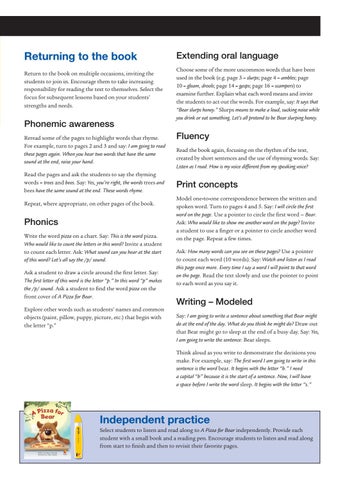Returning to the book Return to the book on multiple occasions, inviting the students to join in. Encourage them to take increasing responsibility for reading the text to themselves. Select the focus for subsequent lessons based on your students’ strengths and needs.
Phonemic awareness Reread some of the pages to highlight words that rhyme. For example, turn to pages 2 and 3 and say: I am going to read these pages again. When you hear two words that have the same sound at the end, raise your hand. Read the pages and ask the students to say the rhyming words – trees and bees. Say: Yes, you’re right, the words trees and bees have the same sound at the end. These words rhyme. Repeat, where appropriate, on other pages of the book.
Phonics Write the word pizza on a chart. Say: This is the word pizza. Who would like to count the letters in this word? Invite a student to count each letter. Ask: What sound can you hear at the start of this word? Let’s all say the /p/ sound. Ask a student to draw a circle around the first letter. Say: The first letter of this word is the letter “p.” In this word “p” makes the /p/ sound. Ask a student to find the word pizza on the front cover of A Pizza for Bear. Explore other words such as students’ names and common objects (paint, pillow, puppy, picture, etc.) that begin with the letter “p.”
Extending oral language Choose some of the more uncommon words that have been used in the book (e.g. page 3 – slurps; page 4 – ambles; page 10 – gleam, drools; page 14 – gasps; page 16 – scampers) to examine further. Explain what each word means and invite the students to act out the words. For example, say: It says that “Bear slurps honey.” Slurps means to make a loud, sucking noise while you drink or eat something. Let’s all pretend to be Bear slurping honey.
Fluency Read the book again, focusing on the rhythm of the text, created by short sentences and the use of rhyming words. Say: Listen as I read. How is my voice different from my speaking voice?
Print concepts Model one-to-one correspondence between the written and spoken word. Turn to pages 4 and 5. Say: I will circle the first word on the page. Use a pointer to circle the first word – Bear. Ask: Who would like to show me another word on the page? Invite a student to use a finger or a pointer to circle another word on the page. Repeat a few times. Ask: How many words can you see on these pages? Use a pointer to count each word (10 words). Say: Watch and listen as I read this page once more. Every time I say a word I will point to that word on the page. Read the text slowly and use the pointer to point to each word as you say it.
Writing – Modeled Say: I am going to write a sentence about something that Bear might do at the end of the day. What do you think he might do? Draw out that Bear might go to sleep at the end of a busy day. Say: Yes, I am going to write the sentence: Bear sleeps. Think aloud as you write to demonstrate the decisions you make. For example, say: The first word I am going to write in this sentence is the word bear. It begins with the letter “b.” I need a capital “b” because it is the start of a sentence. Now, I will leave a space before I write the word sleep. It begins with the letter “s.”
THIS FILE IS NOT ARTWORK - Please use this file for position only
Independent practice Select students to listen and read along to A Pizza for Bear independently. Provide each student with a small book and a reading pen. Encourage students to listen and read along from start to finish and then to revisit their favorite pages.
